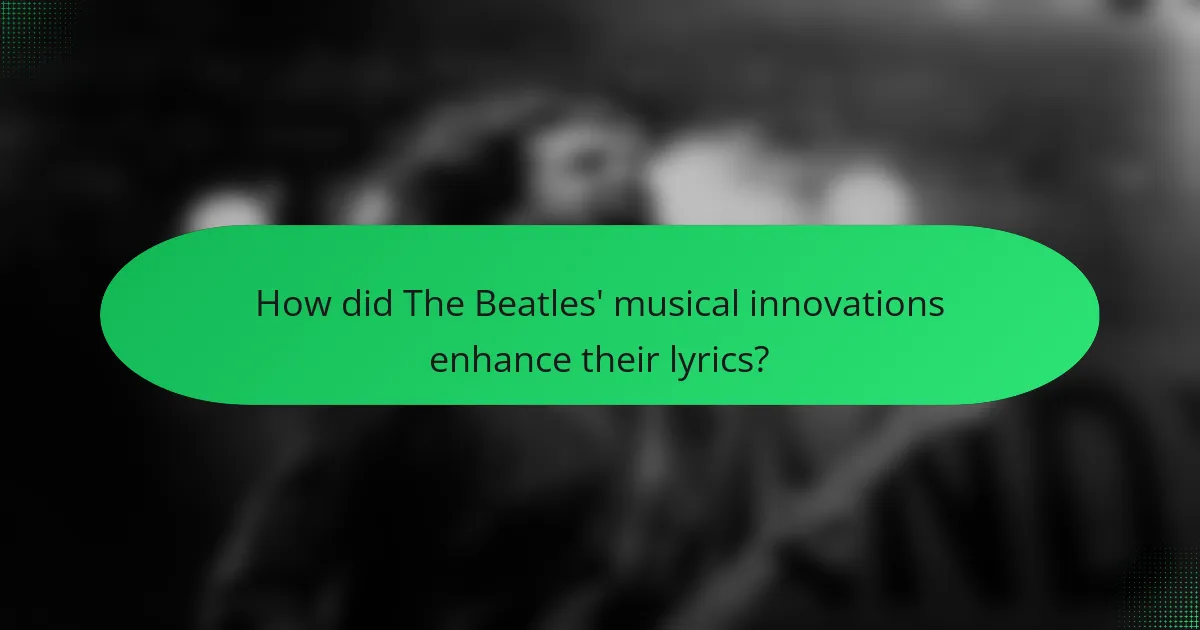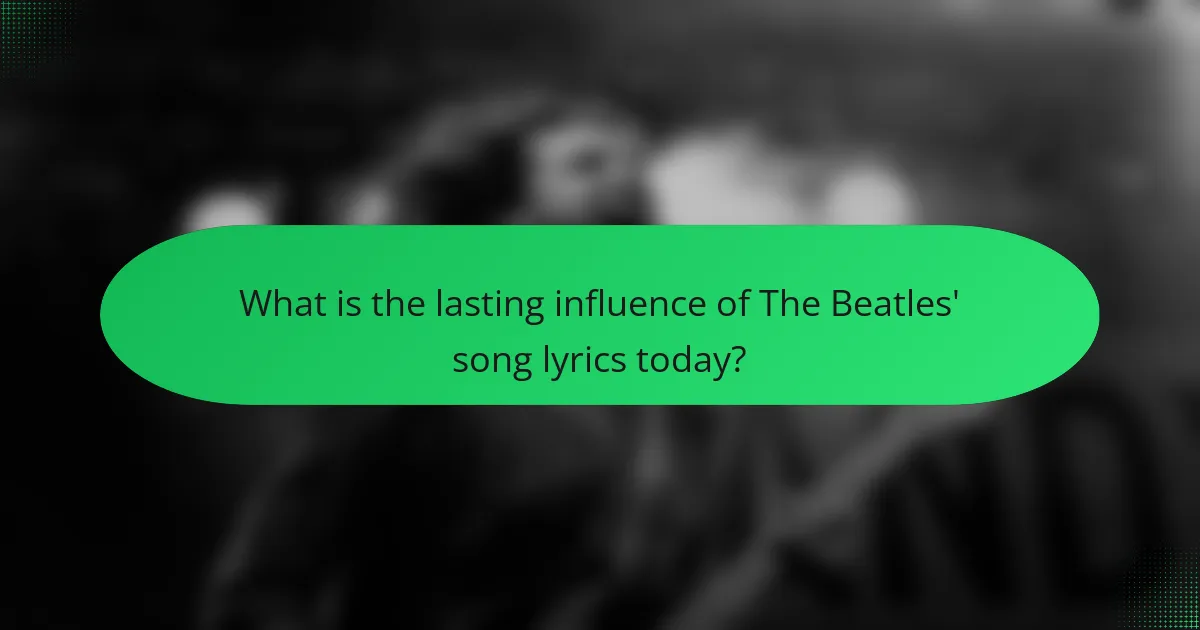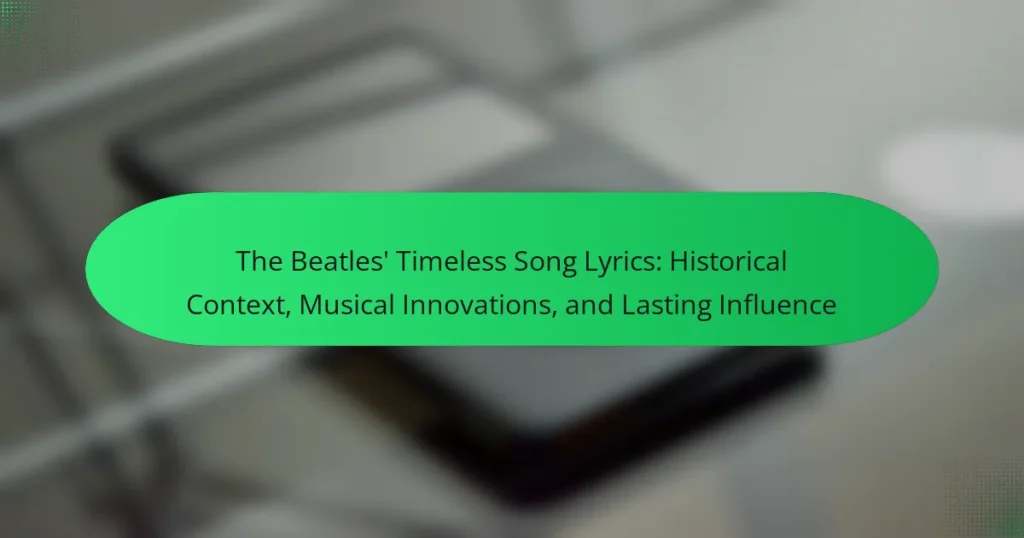The Beatles are a pivotal musical entity known for their impactful song lyrics, which explore universal themes such as love, loss, and social issues. Their lyrics are characterized by vivid imagery and relatable experiences, allowing listeners to form personal connections. The article examines the historical context of The Beatles’ lyrics, highlighting their innovative musical techniques and genre blending that enhanced emotional expression. It also discusses the profound and lasting influence of their lyrical themes on contemporary music and culture, showcasing their relevance across generations. The combination of lyrical depth and musical innovation positions The Beatles as a significant force in the evolution of popular songwriting.

What makes The Beatles’ song lyrics timeless?
The Beatles’ song lyrics are timeless due to their universal themes and emotional depth. Their lyrics explore love, loss, and social issues, resonating with audiences across generations. The songs often incorporate vivid imagery and relatable experiences. This lyrical richness allows listeners to connect on a personal level. Additionally, the innovative use of language and wordplay adds layers of meaning. Their songs often reflect the cultural and societal changes of the 1960s, making them historically significant. The Beatles’ ability to blend simplicity with complexity in their lyrics contributes to their lasting appeal. The combination of these elements ensures their music remains relevant today.
How did The Beatles’ lyrics reflect the cultural context of their time?
The Beatles’ lyrics reflected the cultural context of their time by addressing social change and youth identity. Their songs captured the spirit of the 1960s, a period marked by civil rights movements and anti-war sentiments. For example, “Revolution” directly engaged with political activism. Additionally, “All You Need Is Love” promoted messages of peace and love during a turbulent era. The band’s use of innovative language and imagery resonated with a generation seeking new forms of expression. Their lyrics often mirrored the evolving attitudes towards love, relationships, and societal norms. This alignment with contemporary issues contributed to their widespread appeal and cultural significance.
What historical events influenced the themes in their lyrics?
The Beatles’ lyrics were influenced by significant historical events. The social upheaval of the 1960s shaped their themes. The Civil Rights Movement inspired songs advocating for peace and equality. The Vietnam War prompted anti-war sentiments in their music. The counterculture movement influenced their exploration of love and freedom. Events like the assassination of political figures added depth to their storytelling. Additionally, the cultural shifts in Britain post-World War II affected their perspectives. These historical contexts are evident in songs like “Revolution” and “Blackbird.”
How did societal changes shape the messages in their songs?
Societal changes significantly shaped the messages in The Beatles’ songs. The band emerged during the 1960s, a time of profound social upheaval. Issues like civil rights, anti-war protests, and counterculture movements influenced their lyrics. For example, “Revolution” directly addressed the political climate and calls for change. The growing youth culture also encouraged themes of love, freedom, and experimentation in their music. Songs like “All You Need Is Love” reflected the desire for unity and peace. The Beatles’ ability to capture these sentiments resonated with their audience. Their lyrics evolved in response to changing societal norms and values. This connection to contemporary issues solidified their impact on music and culture.
Why are The Beatles’ lyrics considered innovative?
The Beatles’ lyrics are considered innovative due to their unique storytelling and exploration of complex themes. They often incorporated personal experiences and societal issues into their songs. This approach was relatively uncommon in popular music at the time. For instance, songs like “Eleanor Rigby” addressed loneliness and isolation, which resonated with listeners. Additionally, their use of wordplay and surreal imagery set them apart from their contemporaries. Tracks such as “Lucy in the Sky with Diamonds” showcased their experimental style. The Beatles also pushed the boundaries of traditional song structures, integrating diverse musical influences. Their willingness to tackle subjects like love, loss, and existentialism marked a significant shift in songwriting. Overall, their innovative lyrics helped elevate popular music to an art form.
What literary techniques did The Beatles use in their songwriting?
The Beatles used various literary techniques in their songwriting, including imagery, metaphor, and wordplay. Imagery creates vivid pictures in the listener’s mind. For example, in “Lucy in the Sky with Diamonds,” they evoke a dreamlike landscape. Metaphors convey deeper meanings, as seen in “All You Need Is Love,” where love symbolizes universal connection. Wordplay adds cleverness, like in “I Am the Walrus,” which features nonsensical phrases that engage listeners. These techniques contribute to the richness of their lyrics. Their innovative use of language has influenced countless artists and remains a hallmark of their songwriting.
How did their approach to storytelling set them apart from other artists?
The Beatles’ approach to storytelling set them apart through their innovative use of narrative and character development in their lyrics. They incorporated vivid imagery and relatable themes that resonated with a wide audience. Songs like “Eleanor Rigby” and “Lucy in the Sky with Diamonds” showcase their ability to create detailed characters and scenarios. This narrative depth was uncommon in popular music at the time. Their storytelling often reflected social issues and personal experiences, adding layers of meaning. This connection to listeners’ lives fostered a unique emotional engagement. Their pioneering techniques influenced countless artists, establishing a new standard for lyrical content in music.
In what ways did The Beatles’ lyrics impact music and culture?
The Beatles’ lyrics significantly impacted music and culture by introducing innovative storytelling and social commentary. Their songs often explored themes of love, peace, and existentialism. This lyrical depth resonated with the youth of the 1960s, reflecting their experiences and aspirations. The Beatles’ use of wordplay and abstract imagery expanded the boundaries of popular music. Songs like “A Day in the Life” showcased complex structures and unconventional narratives. Their influence led to a shift in the music industry, encouraging artists to prioritize lyrical content. This change contributed to the emergence of singer-songwriters and concept albums. The Beatles’ lyrics also played a role in the cultural revolution, inspiring movements for social change. Their music remains a reference point for artists across genres, demonstrating the lasting power of their lyrical contributions.
What lasting influence did their lyrics have on future generations of musicians?
The Beatles’ lyrics profoundly influenced future generations of musicians. Their innovative storytelling and emotional depth set new standards in songwriting. They tackled complex themes such as love, social issues, and introspection. This encouraged artists to explore similar topics in their own work. Many musicians cite The Beatles as a primary inspiration for their songwriting. For instance, Bob Dylan admired their lyrical sophistication and incorporated similar techniques. Additionally, their experimentation with form and structure paved the way for diverse genres. The Beatles’ ability to blend music with meaningful lyrics reshaped the expectations of popular music. Their legacy continues to inspire songwriters and musicians globally.
How have their themes resonated with audiences over the decades?
The Beatles’ themes have resonated deeply with audiences over the decades. Their exploration of love, peace, and social change has remained relevant. Songs like “All You Need Is Love” became anthems for the counterculture movement in the 1960s. The universal nature of their lyrics appeals to multiple generations. Their ability to address personal and societal issues fosters connection among listeners. The band’s innovative sound influences countless artists today. Research indicates that their music continues to chart globally, demonstrating ongoing popularity. The Beatles’ themes reflect human experiences, ensuring their legacy endures.

How did The Beatles’ musical innovations enhance their lyrics?
The Beatles’ musical innovations significantly enhanced their lyrics by integrating diverse genres and advanced recording techniques. They incorporated elements of classical music, Indian music, and rock and roll, creating a unique sound. This blend allowed for more complex emotional expression in their lyrics. For instance, the use of unconventional chord progressions added depth to songs like “Eleanor Rigby.” Their experimentation with studio techniques, such as tape loops and backward recording, created a new sonic landscape. This innovation supported the narrative and thematic richness found in tracks like “A Day in the Life.” Overall, their musical advancements provided a framework for more sophisticated lyrical storytelling.
What musical elements contributed to the depth of their lyrics?
Melody, harmony, and rhythm contributed significantly to the depth of The Beatles’ lyrics. Their melodies often featured unexpected intervals, enhancing emotional resonance. Harmonically, they employed complex chord progressions that supported lyrical themes. Rhythmic variation added dynamism to their songs, allowing for nuanced expression. For example, “A Day in the Life” combines varied tempos and time signatures, deepening its narrative impact. Additionally, the use of counterpoint in songs like “Because” enriched the lyrical experience. These musical elements work together to create a profound connection between the music and the lyrics.
How did their use of melody and harmony complement their lyrical themes?
The Beatles’ use of melody and harmony significantly complemented their lyrical themes. Their melodies often mirrored the emotional tone of the lyrics. For instance, in “Yesterday,” the melancholic melody enhances the song’s themes of loss and longing. Harmonies were frequently employed to add depth and richness. Songs like “Because” showcase intricate harmonies that elevate the spiritual and introspective lyrics. The contrast between upbeat melodies and serious themes can be seen in “Eleanor Rigby.” Here, the lively musical arrangement juxtaposes the somber story of loneliness. This interplay between melody, harmony, and lyrics creates a more profound listening experience. The Beatles’ innovative approach to these elements solidified their influence in music history.
What role did experimentation play in their songwriting process?
Experimentation was crucial in The Beatles’ songwriting process. They frequently explored new musical styles and techniques. This included incorporating unconventional instruments, such as the sitar in “Norwegian Wood.” They also experimented with song structures, moving away from traditional verse-chorus formats. The use of studio technology, like tape loops and backward recordings, was innovative. Their willingness to push boundaries led to groundbreaking albums like “Sgt. Pepper’s Lonely Hearts Club Band.” This approach not only defined their sound but also influenced future generations of musicians. The Beatles’ experimentation showcased their creative evolution and desire to challenge musical norms.
How did The Beatles’ collaboration influence their lyrical content?
The Beatles’ collaboration significantly influenced their lyrical content by fostering a unique blend of ideas and styles. John Lennon and Paul McCartney often wrote together, merging their distinct perspectives. This partnership allowed for a diverse range of themes in their songs. For example, their collaboration led to the exploration of love, social issues, and introspection. George Harrison’s contributions added spiritual and philosophical dimensions. Their collective effort resulted in innovative storytelling techniques and complex narratives. The synergy among the members enriched their lyrics, making them resonate with a wide audience. This collaborative process is evident in iconic songs like “A Day in the Life” and “Lucy in the Sky with Diamonds.” Their ability to combine various influences created a lasting impact on popular music.
What impact did the partnership between Lennon and McCartney have on their lyrics?
The partnership between Lennon and McCartney significantly enhanced the depth and variety of their lyrics. Their collaboration resulted in a unique fusion of personal and universal themes. Lennon often contributed introspective and socially conscious elements. McCartney typically added melodic and romantic aspects to their songs. This dynamic created a balance that appealed to a wide audience. Their combined efforts led to innovative storytelling techniques in popular music. For instance, songs like “A Day in the Life” showcased their ability to blend different perspectives. The partnership also encouraged experimentation with lyrical structures and forms. This evolution in their songwriting set a precedent for future artists in the rock genre.
How did input from other band members shape their songs?
Input from other band members significantly shaped The Beatles’ songs. Each member contributed unique musical ideas and lyrical themes. John Lennon often brought introspective and experimental elements. Paul McCartney added melodic structure and pop sensibility. George Harrison introduced Indian influences and spiritual themes. Ringo Starr contributed rhythmic diversity and simplicity. Collaborative songwriting sessions led to innovative arrangements. For example, “A Day in the Life” showcases their combined creativity. The interplay of their distinct styles created a rich musical tapestry. This collaborative approach was crucial in defining their iconic sound.

What is the lasting influence of The Beatles’ song lyrics today?
The lasting influence of The Beatles’ song lyrics today is profound and far-reaching. Their lyrics introduced complex themes, including love, social issues, and existential questions. This lyrical depth has inspired countless artists across various genres. The Beatles’ songs contributed to the evolution of popular music and songwriting. Their innovative use of language and metaphor reshaped lyrical standards. For instance, “A Day in the Life” showcases narrative storytelling within a song. Their influence is evident in contemporary music, where artists often cite them as inspirations. Research indicates that The Beatles’ lyrical themes remain relevant in today’s cultural conversations. Their ability to connect with universal emotions ensures their lyrics continue to resonate with new generations.
How do contemporary artists draw inspiration from The Beatles’ lyrics?
Contemporary artists draw inspiration from The Beatles’ lyrics by exploring themes of love, individuality, and social change. The Beatles’ lyrics often reflect personal experiences and societal issues, which resonate with modern audiences. Artists like Ed Sheeran and Billie Eilish have cited The Beatles as influences in their songwriting. They incorporate similar storytelling techniques and emotional depth in their own work. Additionally, The Beatles’ innovative approach to music and lyrics has inspired artists to experiment with genre and form. Their ability to blend various musical styles encourages contemporary musicians to push creative boundaries. The Beatles’ lyrical legacy continues to shape the landscape of modern music, making their influence undeniably profound.
What themes from The Beatles’ lyrics are still relevant in today’s music?
Themes from The Beatles’ lyrics that remain relevant today include love, peace, and self-discovery. Love is a universal theme, explored in songs like “All You Need Is Love.” This message continues to resonate in contemporary music across genres. Peace, highlighted in “Give Peace a Chance,” remains a critical topic amid ongoing global conflicts. Self-discovery, evident in “Across the Universe,” reflects personal journeys that artists still address. These themes influence modern songwriters and connect with listeners on emotional levels. The Beatles’ ability to articulate these experiences contributes to their lasting impact on music today.
How have modern interpretations of their lyrics evolved?
Modern interpretations of The Beatles’ lyrics have evolved to reflect contemporary social issues. Their themes of love, peace, and personal struggle resonate with current movements like mental health awareness and social justice. Scholars and fans analyze the lyrics through new lenses, emphasizing their relevance today. For example, songs like “Revolution” are often discussed in the context of today’s political activism. Additionally, the rise of digital media has facilitated broader discussions about their meanings. Online forums and social media platforms allow for diverse interpretations and collaborations. This evolution showcases the timeless nature of their work while adapting to modern cultural contexts.
What lessons can be learned from The Beatles’ songwriting approach?
The Beatles’ songwriting approach teaches the importance of collaboration and experimentation. They often wrote songs together, blending their unique styles and ideas. This collaboration fostered creativity and innovation in their music. Additionally, they embraced diverse musical influences, incorporating elements from various genres. Their willingness to experiment with song structure and instrumentation set them apart. For instance, songs like “A Day in the Life” showcased unconventional forms. Their lyrical depth also emphasized storytelling and emotional resonance. This approach helped them connect with a wide audience. Overall, The Beatles demonstrated that collaboration and creativity can lead to groundbreaking work in music.
How can aspiring songwriters apply The Beatles’ techniques to their own work?
Aspiring songwriters can apply The Beatles’ techniques by studying their use of innovative song structures. The Beatles often experimented with verse-chorus formats, blending different styles within a single song. For example, “A Day in the Life” features contrasting sections that create a dynamic listening experience.
Additionally, they incorporated rich storytelling in their lyrics. Songs like “Eleanor Rigby” showcase character-driven narratives that resonate emotionally. This technique encourages songwriters to craft relatable stories in their own work.
Moreover, The Beatles utilized harmonies and vocal arrangements effectively. Their use of three-part harmonies in tracks like “Because” enhances the musical depth. Aspiring songwriters should explore vocal layering to enrich their compositions.
Lastly, they embraced collaboration and feedback. The partnership between John Lennon and Paul McCartney exemplifies how collaboration can lead to creative breakthroughs. Aspiring songwriters should seek partnerships to enhance their songwriting process.
What best practices can be derived from The Beatles’ lyrical legacy?
Best practices derived from The Beatles’ lyrical legacy include the use of relatable themes, innovative storytelling, and emotional resonance. The Beatles often wrote about universal experiences, making their lyrics accessible to a broad audience. They utilized narrative techniques, creating vivid imagery and character-driven stories in songs like “Eleanor Rigby.” Their ability to convey complex emotions through simple language resonates deeply with listeners. Additionally, they experimented with different musical styles and lyrical structures, showcasing versatility. The Beatles’ collaboration and openness to feedback enhanced their creative process. Their legacy demonstrates the importance of authenticity and innovation in songwriting.
The Beatles’ song lyrics are recognized for their timeless quality, characterized by universal themes, emotional depth, and innovative storytelling. The article examines how their lyrics reflect the cultural context of the 1960s, addressing social issues and significant historical events. It also highlights the band’s musical innovations, including the use of diverse genres and advanced recording techniques, which enhanced their lyrical content. Furthermore, the lasting influence of The Beatles’ lyrics on contemporary music and their relevance in today’s cultural conversations are explored, along with lessons aspiring songwriters can learn from their approach.

